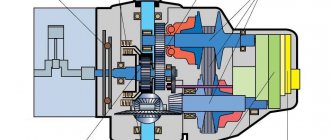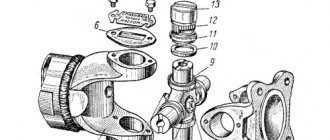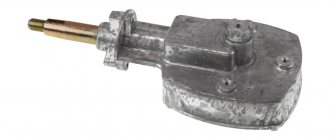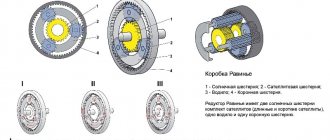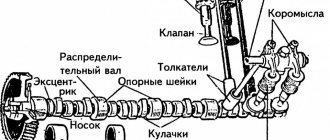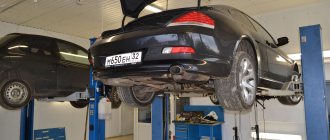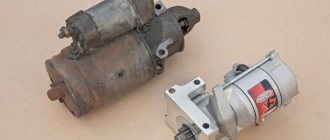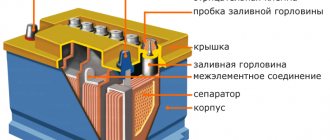A differential is a device that controls the distribution of torque from the input shaft to the output shaft, and the speed of each individual element may differ. The mechanism is widely used in the automotive industry.
Differentials vary according to installation location, purpose and design features:
- In cars with a single axle drive, only one differential is used, called a cross-axle differential. Its necessity is caused by the fact that the outer and inner wheels travel different distances when turning a vehicle.
- Vehicles with 6×6 or 8×8 drives contain an additional inter-vehicle differential.
- In all-wheel drive models, as many as three differentials are installed: two interwheel and one interaxle.
We will talk in more detail about how the center differential works, and what kind of center differentials there can be in general.
What is a center differential?
As a rule, the secret of the endurance of SUVs lies in their special design, which is based on a frame of increased rigidity, a powerful engine, as well as the presence of an all-wheel drive system and a transfer case that distributes torque to the vehicle axles and, if necessary, increases it to the desired value.
In turn, the new generation “transfer case” consists of such elements as a center differential, a chain-type transmission that serves to transmit engine torque to the front axle of the car, and a reduction gear. At the same time, it is the presence of a center differential that can be called the main distinguishing feature of the transfer case structure, which is an integral part of the all-wheel drive system. This element is necessary to ensure that the driving axles of the vehicle can rotate at different speeds. And, to fully realize the capabilities of the system, it has such a function as locking the center differential, which is the most effective way to improve the vehicle’s cross-country ability.
This function can be implemented automatically or manually. In the second case, the blocking is carried out by the driver himself. This happens using a special device - a drive, which can be mechanical, hydraulic, electric or pneumatic. This type of blocking is called forced.
Forced locking of the center differential implies an actual complete cessation of its functions and transformation into a conventional clutch, which rigidly couples the axle shafts or cardans of the car and transmits to them the same amount of torque at the same angular velocity. It is used to overcome difficult-to-pass areas with the machine, and when passing them it must be turned off.
Automatic locking, otherwise known as partial slip differential locking, is accomplished using designs such as:
- Viscous coupling,
- Torsen differential,
- Friction clutch.
Selective (switchable) all-wheel drive
Selective all-wheel drive could combine the advantages of part-time and full-time. The most famous of them is Super Select from Mitsubishi (Pajero, Pajero Sport, Delica), although there were many similar systems: Multi-Mode from Toyota (Hilux Surf, 4Runner, Sequoia), All-mode 4WD from Nissan (Pathfinder), SelecTrac from Jeep (Grand Cherokee) and others. Not “Super-Select” alone!
Selective all-wheel drive is switchable full-time. The car can drive in rear-wheel drive to save fuel and improve dynamics (as in part-time), and if necessary, the driver connects the “front”, and without restrictions: there is a center differential, so you can drive in all-wheel drive on any surface and on any terrain. any speeds. Of course, there is also a hard locking of the central differential, because selective 4WD systems are found only on full-fledged SUVs.
Ideal all-wheel drive? Perhaps - as long as everything works properly. The large number of modes has complicated the design, and over time, problems with sensors, controllers, actuators and other parts of this certainly advanced 4WD system are inevitable.
Pros and cons of selective 4WD
✅ Ability to disable 4WD to save fuel.
✅ Ability to drive 4WD on any surface.
⛔ Overcomplication of the design, possibility of failures.
Viscous coupling, its structure and mechanism of action
The viscous coupling is attached by one drive to the differential cup, while its second end is attached to the car's axle shaft. When the vehicle is in normal driving mode, the cup and axle shaft rotate at the same angular speeds. These indicators may differ only slightly from each other when cornering. That is, the working planes of the viscous coupling themselves at this time have a minimal percentage of divergence, and it itself is in an open form. If a greater value of torque is transmitted to any of the axles of the car, as a result of which its rotation speed significantly exceeds that of the other axles, friction arises in the viscous coupling, which causes it to block.
It turns out that the more the angular speeds of rotation of the car axles differ from each other, the more friction occurs in the viscous coupling and the stronger the degree of its blocking becomes. In turn, after they are aligned, friction gradually decreases, which leads to a smooth opening of the viscous coupling and the blocking is disabled.
This center differential lock performs best when the vehicle is used on low-quality surfaces, but in real off-road conditions it does not perform well. The fact is that a viscous coupling is simply not able to cope with rapid and frequent changes in the state of adhesion between car axles and the ground, which is why it overheats and fails.
"Haldex"
THIS NAME is derived from the name of the Swedish company “Haldex”, which was the first in the world to develop and patent a differential based on an electronically controlled multi-plate clutch. Recently, such devices have become more and more popular. Moreover, the vast majority of automakers use differentials on their models produced directly by Haldex. The fact is that such couplings are produced in the form of a single unit, easily adaptable for installation on almost any car.
In its design, the Haldex coupling is partly similar to a visco coupling, but differs from it in its operating principle. In the Swedish device, blocking is done not by changing the properties of the liquid poured into the body, but by compressing the disks using an electronically controlled hydraulic drive. For example, if the sensors detect that one differential shaft has begun to rotate faster, the control unit immediately commands the electric pump to increase the pressure in the system and press one disk against the other. Thus, “Haldex” is blocked. And by adjusting the compression force of the disks, the electronic unit also controls the degree of clutch locking.
Relatively low cost, minimal delays in operation and flexibility of settings are the main advantages of the Haldex type hydraulic multi-plate clutch. Therefore, on modern cars such devices are widely used both in conjunction with a conventional differential (to lock it) and instead of it (for example, to connect all-wheel drive on many SUVs). Nissan X-Trail, Renault Koleos, VW Tiguan, Mitsubishi Outlander XL, Toyota RAV4, Audi TT, Audi A3, etc. can boast of such a transmission, based on a multi-plate hydraulic clutch. VW Golf 4Motion” and, naturally, all all-wheel drive “Volvo” models.
Features of the Torsen differential device and its types
In turn, the Torsen limited-slip differential is one of the most high-tech and effective forms of locking. It is distinguished by a better reaction and the ability to “respond” to changes in the amount of torque in the shortest possible time, responding to this by changing the degree of blocking. It is SUVs with a center differential of this type of lock that are the most reliable. Its action is based on the properties of a hypoid or helical pair of gears, which, if necessary, can be “wedged”. This type of design has three varieties:
Type 1
Gears and satellites of the driving axle shafts are used here as hypoid pairs. The satellites of the opposite semi-axes, located in a perpendicular position relative to them, are connected to each other by spur-type gears.
In normal driving mode, when the torques are distributed equally on the axles of the car, these pairs are in a stationary position or move with low intensity, providing an optimal difference in the angular speeds of the axles when cornering. In cases where one of the axles, which is expressed in a drop in torque on it, the satellite-axle pairs begin rotational movements, which leads to friction and partial blocking of the differential. In turn, at the same moment, torque is distributed in favor of the less intensively working axle shaft.
It is worth noting that the Torsen type 1 differential has the most powerful design in its class, as it operates in the widest range of torque ratios - from 2.5/1 to 5.0/1.
Type 2
The design of this differential, created by the English designer Rod Quaife, uses helical-type axle gears and helical gears of satellites located parallel to the axle shafts. If we compare them with the previous type, we can see that the center differential design of this type is characterized by a lower blocking coefficient, compensated by a higher response speed and greater sensitivity to changes in the transmitted torque. Similar mechanisms are used on domestically produced cars, including UAZs.
Type 3
The Torsen center differential device of the third type from the Zexel Torsen company is largely similar in its design features and operating principle to the second type. Helical-type axle gears and helical satellite gears are also used here, the axes of which are in a parallel position with respect to the axle shafts.
Thanks to the planetary structure of this design, the nominal torque distribution is shifted in favor of one or the other axle of the car. The main advantage of this type of locking device is its functionality and compactness, which makes it possible to simplify the design of the transfer case and reduce its size.
Content
- 1 Purpose
- 2 Device
- 3 Location
- 4 The problem of a slipping wheel
- 5 History of ways to solve the problem of a slipping wheel
- 6 Self-locking differential
- 7 Forced locking differentials 7.1 Manual differential lock
- 7.2 Electronic differential control
- 7.3 DPS
Structural differences between friction clutches
The design of the friction clutch includes a drum, which has a direct connection with the car hub, several friction friction discs (two or more), a piston that compresses these discs and a spring that returns the piston to its original position.
There is a rigid connection between the drum and the hub. In this case, inside the latter there is a ring that acts as a stopper, on which there is a disc spring resting on the piston. In turn, the hub is equipped with special channels that move oil between the piston and the drum. In passenger cars, disc friction clutches are most often used, having two friction surfaces, consisting of one disc and two coupling halves, and a multi-disc design can more often be found on specialized vehicles, including tractors.
Let's consider how a center differential with a friction clutch works: when the car is in normal, smooth driving mode, the distribution of angular velocities between the axles of the car occurs evenly. However, when any of the axle shafts begins to rotate faster, the friction discs begin to move closer to each other, slowing it down using the friction forces that arise.
This type of locking system is highly effective, but is rarely seen on production passenger cars. This trend is explained by the complexity of the design and the special specifics of servicing friction differentials, as well as the short service life caused by the rapid wear of their components.
The operating principle of a friction-type center differential is used in the Haldex coupling, which has been produced since 1998 by a Swedish company of the same name. Manufacturers based the operation of this device on an electro-hydraulic combination of elements. But, despite the progressiveness and innovative spirit of the Haldex coupling, its first versions were more likely to fail than to be successful, which necessitated numerous design improvements, and the latest developments turned out to be very successful and in demand.
Currently, the 5th generation of the Haldex coupling is being produced, featuring improved characteristics, including:
- the ability to control the device regardless of the driving mode;
- ability to quickly increase torque using feedforward control;
- possibility of constant operation of the rear main gear;
- compatibility with various car brake control systems, including ABS.
History of ways to solve the problem of a slipping wheel
- 1825 - Onesiphore Pecqueur (1792-1852)
invented the differential. - 1932 - Ferdinand Porsche began research into slip differentials.
- 1935 - ZF Friedrichshafen AG, a company collaborating with Porsche, launched a cam differential, which was subsequently used on early Volkswagen models (Type B-70)[1].
- 1956 - the American company Packard was one of the first to begin producing models with an LSD differential under the brand name “Twin Traction”. In the 60s, many companies began producing LSD differentials under various brand names: Alfa Romeo: Q2
- American Motors: Twin-Grip
- Buick: Positive Traction
- Cadillac: Controlled
- Chevrolet/GMC: Positraction
- Chrysler: Sure Grip
- Dana Corporation:Trak-Lok or Powr-Lok
- Ferrari: E-Diff
- Fiat: Viscodrive
- Ford: Equa-Lock and Traction-Lok
- International: Trak-Lok or Power-Lok
- Jeep: Trac-Lok (clutch-type mechanical), Tru-Lok (gear-type mechanical), and Vari-Lok (gerotor pump), Power Lok
- Oldsmobile: Anti-Spin
- Pontiac: Safe-T-Track
- Porsche: PSD (electro-hydraulic mechanical)
- Saab: Saab XWD eLSD
- Studebaker-Packard Corporation: Twin Traction
About viscous type systems
The hydraulic couplings of such devices have a large number of disks, and the working surfaces of these disks are sticky. The system works approximately the same as disk mechanisms. A special silicone-based solution is poured into the hydraulic system. It has a special property, which is the ability to harden when heated. At this time, the disks begin to transmit force to the axle shafts, taking into account the difference in parameters when the input and output shafts rotate.
Heating of the liquid occurs only at different speeds of rotation of the axle shafts. This design has its own peculiarity. With a long period of wheel slipping, the initial stage of blocking occurs softly, and then the force increases, which increases the efficiency of wheel blocking. Such structures require virtually no maintenance or care, but the tightness of the structure is required.
A little about forced blocking
On all vehicles intended for driving in poor road conditions. It is mandatory to install a mechanism that can forcibly stop the rotation of the satellites for some time. This is done by the driver using a mechanical or pneumatic shutdown method. After this, both drive wheels have the same speed.
Drivers should take into account one negative aspect of this inclusion. Driving on winding roads with this differential position will not only increase fuel consumption, but also accelerate tire wear. Therefore, after finishing a bad section of the road, the driver must turn it off.
